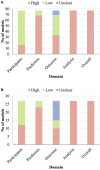Prediction Models for Prognosis of Cervical Cancer: Systematic Review and Critical Appraisal
- PMID: 34026714
- PMCID: PMC8137851
- DOI: 10.3389/fpubh.2021.654454
Prediction Models for Prognosis of Cervical Cancer: Systematic Review and Critical Appraisal
Abstract
Objective: This work aims to systematically identify, describe, and appraise all prognostic models for cervical cancer and provide a reference for clinical practice and future research. Methods: We systematically searched PubMed, EMBASE, and Cochrane library databases up to December 2020 and included studies developing, validating, or updating a prognostic model for cervical cancer. Two reviewers extracted information based on the CHecklist for critical Appraisal and data extraction for systematic Reviews of prediction Modeling Studies checklist and assessed the risk of bias using the Prediction model Risk Of Bias ASsessment Tool. Results: Fifty-six eligible articles were identified, describing the development of 77 prognostic models and 27 external validation efforts. The 77 prognostic models focused on three types of cervical cancer patients at different stages, i.e., patients with early-stage cervical cancer (n = 29; 38%), patients with locally advanced cervical cancer (n = 27; 35%), and all-stage cervical cancer patients (n = 21; 27%). Among the 77 models, the most frequently used predictors were lymph node status (n = 57; 74%), the International Federation of Gynecology and Obstetrics stage (n = 42; 55%), histological types (n = 38; 49%), and tumor size (n = 37; 48%). The number of models that applied internal validation, presented a full equation, and assessed model calibration was 52 (68%), 16 (21%), and 45 (58%), respectively. Twenty-four models were externally validated, among which three were validated twice. None of the models were assessed with an overall low risk of bias. The Prediction Model of Failure in Locally Advanced Cervical Cancer model was externally validated twice, with acceptable performance, and seemed to be the most reliable. Conclusions: Methodological details including internal validation, sample size, and handling of missing data need to be emphasized on, and external validation is needed to facilitate the application and generalization of models for cervical cancer.
Keywords: cervical cancer; prediction model; predictors; risk of bias; statistical analysis.
Copyright © 2021 He, Chen, Liu, Hou, Zhu, Cheng, Zhang, Zhan and Wang.
Conflict of interest statement
The authors declare that the research was conducted in the absence of any commercial or financial relationships that could be construed as a potential conflict of interest.
Figures



Similar articles
-
[The risk prediction models for occurrence of cervical cancer: a systematic review].Zhonghua Liu Xing Bing Xue Za Zhi. 2021 Oct 10;42(10):1855-1862. doi: 10.3760/cma.j.cn112338-20200806-01031. Zhonghua Liu Xing Bing Xue Za Zhi. 2021. PMID: 34814624 Chinese.
-
External validation of prognostic models to predict stillbirth using International Prediction of Pregnancy Complications (IPPIC) Network database: individual participant data meta-analysis.Ultrasound Obstet Gynecol. 2022 Feb;59(2):209-219. doi: 10.1002/uog.23757. Ultrasound Obstet Gynecol. 2022. PMID: 34405928
-
Predictive accuracy of risk prediction models for recurrence, metastasis and survival for early-stage cutaneous melanoma: a systematic review.BMJ Open. 2023 Sep 28;13(9):e073306. doi: 10.1136/bmjopen-2023-073306. BMJ Open. 2023. PMID: 37770261 Free PMC article.
-
Prognostic models for outcome prediction in patients with chronic obstructive pulmonary disease: systematic review and critical appraisal.BMJ. 2019 Oct 4;367:l5358. doi: 10.1136/bmj.l5358. BMJ. 2019. PMID: 31585960 Free PMC article.
-
Prognostic models for outcome prediction in patients with advanced hepatocellular carcinoma treated by systemic therapy: a systematic review and critical appraisal.BMC Cancer. 2022 Jul 9;22(1):750. doi: 10.1186/s12885-022-09841-5. BMC Cancer. 2022. PMID: 35810271 Free PMC article.
Cited by
-
Open Source Repository and Online Calculator of Prediction Models for Diagnosis and Prognosis in Oncology.Biomedicines. 2022 Oct 23;10(11):2679. doi: 10.3390/biomedicines10112679. Biomedicines. 2022. PMID: 36359199 Free PMC article.
-
Establishment of a Risk Prediction Model for Pulmonary Infection in Patients with Advanced Cancer.Appl Bionics Biomech. 2022 May 30;2022:6149884. doi: 10.1155/2022/6149884. eCollection 2022. Appl Bionics Biomech. 2022. Retraction in: Appl Bionics Biomech. 2023 Aug 16;2023:9802701. doi: 10.1155/2023/9802701. PMID: 35677196 Free PMC article. Retracted.
-
A Comprehensive Integration of Data Regarding the Correlation of TNF-α rs1800629 Polymorphism with Susceptibility to Cervical Cancer.Asian Pac J Cancer Prev. 2024 Apr 1;25(4):1155-1167. doi: 10.31557/APJCP.2024.25.4.1155. Asian Pac J Cancer Prev. 2024. PMID: 38679974 Free PMC article.
-
Evaluation of changes in prediction modelling in biomedicine using systematic reviews.BMC Med Res Methodol. 2025 Jul 1;25(1):167. doi: 10.1186/s12874-025-02605-2. BMC Med Res Methodol. 2025. PMID: 40597722 Free PMC article.
-
Development and External Validation of Partial Proportional Odds Risk Prediction Models for Cancer Stage at Diagnosis among Males and Females in Canada.Cancers (Basel). 2023 Jul 8;15(14):3545. doi: 10.3390/cancers15143545. Cancers (Basel). 2023. PMID: 37509208 Free PMC article.
References
-
- WHO . WHO Guidelines for Screening and Treatment of Precancerous Lesions for Cervical Cancer Prevention. Geneva, IL: (2013). - PubMed
Publication types
MeSH terms
LinkOut - more resources
Full Text Sources
Other Literature Sources
Medical

